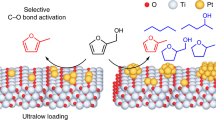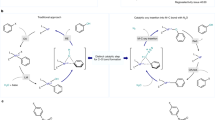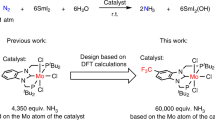Abstract
Developing homogeneous catalysts that convert CS2 and COS pollutants into environmentally benign products is important for both fundamental catalytic research and applied environmental science. Here we report a series of air-stable dimeric Pd complexes that mediate the facile hydrolytic cleavage of both CS2 carbon–sulfur bonds at 25 °C to produce CO2 and trimeric Pd complexes. Oxidation of the trimeric complexes with HNO3 regenerates the dimeric starting complexes with the release of SO2 and NO2. Isotopic labelling confirms that the carbon and oxygen atoms of CO2 originate from CS2 and H2O, respectively, and reaction intermediates were observed by gas-phase and electrospray ionization mass spectrometry, as well as by Fourier transform infrared spectroscopy. We also propose a plausible mechanistic scenario based on the experimentally observed intermediates. The mechanism involves intramolecular attack by a nucleophilic Pd–OH moiety on the carbon atom of coordinated µ-OCS2, which on deprotonation cleaves one C–S bond and simultaneously forms a C–O bond. Coupled C–S cleavage and CO2 release to yield [(bpy)3Pd3(µ3-S)2](NO3)2 (bpy, 2,2′-bipyridine) provides the thermodynamic driving force for the reaction.
This is a preview of subscription content, access via your institution
Access options
Subscribe to this journal
Receive 12 print issues and online access
$259.00 per year
only $21.58 per issue
Buy this article
- Purchase on Springer Link
- Instant access to full article PDF
Prices may be subject to local taxes which are calculated during checkout



Similar content being viewed by others
References
Topsøe, H. et al. The role of reaction pathways and support interactions in the development of high activity hydrotreating catalysts. Catal. Today 107–108, 12–22 (2005).
Wang, L., He, W. & Yu, Z. Transition-metal mediated carbon–sulfur bond activation and transformations. Chem. Soc. Rev. 42, 599–621 (2013).
Gary, J. H., Handwerk, G. E. & Kaiser, M. J. Petroleum Refining: Technology and Economics (CRC, 2007).
Stavtsov, A. K., Drozdovskii, V. N., Irklei, V. M., Mokrousova, L. A. & Napalkova, T. A. Effect of carbon disulfide consumption on the basic properties of viscose prepared from radiation-modified cellulose. Fibre Chem. 23, 396–399 (1992).
Notholt, J. et al. Enhanced upper tropical tropospheric COS: impact on the stratospheric aerosol layer. Science 300, 307–310 (2003).
Sze, N. D. & Ko, M. K. W. CS2 and COS in the stratospheric sulphur budget. Nature 280, 308–310 (1979).
Sze, N. D. & Ko, M. K. W. Is CS2 a precursor for atmospheric COS? Nature 278, 731–732 (1979).
Turco, R. P., Whitten, R. C., Toon, O. B., Pollack, J. B. & Hamill, P. OCS, stratospheric aerosols and climate. Nature 283, 283–285 (1980).
Cox, R. A. & Sheppard, D. Reactions of OH radicals with gaseous sulphur compounds. Nature 284, 330–331 (1980).
Deshmukh, M. M., Ohba, M., Kitagawa, S. & Sakaki, S. Absorption of CO2 and CS2 into the Hofmann-type porous coordination polymer: electrostatic versus dispersion interactions. J. Am. Chem. Soc. 135, 4840–4849 (2013).
Wang, X. Q. et al. Adsorption of carbon disulfide on Cu/CoSPc/Ce modified activated carbon under microtherm and micro-oxygen conditions. Ind. Eng. Chem. Res. 53, 13626–13634 (2014).
Cullis, C. F. & Mulcahy, M. F. R. The kinetics of combustion of gaseous sulphur compounds. Combust. Flame 18, 225–292 (1972).
Laperdrix, E. et al. Comparative study of CS2 hydrolysis catalyzed by alumina and titania. Appl. Catal. B 17, 167–173 (1998).
Mukherjee, S., Das, S. K. & Biswas, M. N. Absorption of carbon disulphide in alkaline solution in spray and ejector columns. Chem. Eng. Process. 46, 181–186 (2007).
Azatyan, V. V. The role of a reaction of direct substitution for a sulfur atom in the CS2 molecule in the combustion of carbon disulfide with oxygen. Kinet. Catal. 44, 459–462 (2003).
Tong, S., Dalla Lana, I. G. & Chuang, K. T. Kinetic modeling of the hydrolysis of carbon disulfide catalyzed by either titania or alumina. Can. J. Chem. Eng. 73, 220–227 (1995).
Smeulders, M. J. et al. Evolution of a new enzyme for carbon disulphide conversion by an acidothermophilic archaeon. Nature 478, 412–416 (2011).
Wang, J. C., Zlotnick, A. & Mecinović, J. Transmission electron microscopy enables the reconstruction of the catenane and ring forms of CS2 hydrolase. Chem. Commun. 50, 10281–10283 (2014).
Werner, H. Novel coordination compounds formed from CS2 and heteroallenes. Coord. Chem. Rev. 43, 165–185 (1982).
Pandey, K. K. Reactivities of carbonyl sulfide (COS), carbon disulfide (CS2) and carbon dioxide (CO2) with transition metal complexes. Coord. Chem. Rev. 140, 37–114 (1995).
Ibers, J. A. Centenary Lecture. Reactivities of carbon disulphide, carbon dioxide, and carbonyl sulphide towards some transition-metal systems. Chem. Soc. Rev. 11, 57–73 (1982).
Lide, D. R. CRC Handbook of Chemistry and Physics (CRC, 2004).
Johnson, A. R. et al. Four-coordinate molybdenum chalcogenide complexes relevant to nitrous oxide N−N bond cleavage by three-coordinate molybdenum(III): synthesis, characterization, reactivity, and thermochemistry. J. Am. Chem. Soc. 120, 2071–2085 (1998).
Ballmann, J. et al. Complete disassembly of carbon disulfide by a ditantalum complex. Chem. Commun. 46, 8794–8796 (2010).
Kallane, S. I. et al. Remarkable reactivity of a rhodium(I) boryl complex towards CO2 and CS2: isolation of a carbido complex. Chem. Commun. 51, 14613–14616 (2015).
Ariafard, A., Brookes, N. J., Stranger, R. & Yates, B. F. Activation of CS2 and CS by ML3 complexes. J. Am. Chem. Soc. 130, 11928–11938 (2008).
Thiemann, M., Scheibler, E. & Wiegand, K. W. in Ullmann's Encyclopedia of Industrial Chemistry (Wiley-VCH, 2000); http://onlinelibrary.wiley.com/doi/10.1002/14356007.a17_293/full
Farrar, D. H., Gukathasan, R. R. & Morris, S. A. Reaction of carbon disulfide with trinuclear palladium and platinum clusters. Crystal structure of Pt2(μ-CS2)2(P(t-Bu)2Ph)2 . Inorg. Chem. 23, 3258–3261 (1984).
Kullberg, M. L. & Kubiak, C. P. Insertions of small molecules, carbon monoxide, methyl isocyanide, sulfur dioxide, and carbon disulphide, into the Pd–Pd σ-bond of Pd2Cl2(PMe2CH2PMe2)2. Crystal and molecular structure of Pd2(μ-CO)Cl2(PMe2CH2PMe2)2 . Inorg. Chem. 25, 26–30 (1986).
Bradford, A. M., Jennings, M. C. & Puddephatt, R. J. Scope and mechanism of oxidative addition of carbon-sulfur double bonds to trinuclear platinum and palladium complexes. Organometallics 8, 2367–2371 (1989).
Ingram, A. J., Solis-Ibarra, D., Zare, R. N. & Waymouth, R. M. Trinuclear Pd3O2 intermediate in aerobic oxidation catalysis. Angew. Chem. Int. Ed. 53, 5648–5652 (2014).
Widegren, J. A. & Finke, R. G. A review of the problem of distinguishing true homogeneous catalysis from soluble or other metal–particle heterogeneous catalysis under reducing conditions. J. Mol. Catal. A 198, 317–341 (2003).
Tzeng, B.-C. et al. Palladium(II) and platinum(II) analogues of luminescent diimine Triangulo complexes supported by triply bridging sulfide ligands: structural and spectroscopic comparisons. Inorg. Chem. 40, 6699–6704 (2001).
Ingram, A. J., Walker, K. L., Zare, R. N. & Waymouth, R. M. Catalytic role of multinuclear palladium–oxygen intermediates in aerobic oxidation followed by hydrogen peroxide disproportionation. J. Am. Chem. Soc. 137, 13632–13646 (2015).
Leoni, P. et al. Synthesis and structure of Pd4(μ-PtBu2)2(μ-CS2)(PPh3)2I2, a neutral palladium(I) derivative with a hexacoordinate carbon and a CS2 molecule bridging four palladium centers. J. Am. Chem. Soc. 119, 8625–8629 (1997).
Tzeng, B.-C., Wu, Y.-L. & Kuo, J.-H. Supramolecular assembly of Triangulo Pd(II) diimine complexes containing triply-bridging sulfide ligands. J. Chin. Chem. Soc. 53, 1033–1038 (2006).
Pugh, L., Rao, K. N. & Rao, K. N. in Molecular Spectroscopy: Modern Research, Vol. II (ed. Rao, K. N.) 165 (Academic, 1976).
Person, W. B., Brown, K. G., Steele, D. & Peters, D. Ab initio calculations of vibrational properties of some linear triatomic molecules. 1. Intensities. J. Phys. Chem. 85, 1998–2007 (1981).
Adrian, R. A., Zhu, S., Klausmeyer, K. K. & Walmsley, J. A. Synthesis and X-ray crystal structure determination of monomeric cis-Pd(2,2′-bipyridine)(NO3)2 . Inorg. Chem. Commun. 10, 1527–1530 (2007).
Fulmer, G. R., Herndon, A. N., Kaminsky, W., Kemp, R. A. & Goldberg, K. I. Hydrogenolysis of palladium(II) hydroxide, phenoxide, and alkoxide complexes. J. Am. Chem. Soc. 133, 17713–17726 (2011).
Yu, S.-Y. et al. Solution self-assembly, spontaneous deprotonation, and crystal structures of bipyrazolate-bridged metallomacrocycles with dimetal centers. Inorg. Chem. 44, 9471–9488 (2005).
Tong, J., Yu, S.-Y. & Li, H. Programmable self-assembly of homo- or hetero-metallomacrocycles using 4-(1H-pyrazolyl-4-yl)pyridine. Chem. Commun. 48, 5343–5345 (2012).
Acknowledgements
This research was supported by National Natural Science Foundation of China (Grant numbers 21471011, 21574135, 91127039, 51303180, 21203245, 21532005, 21327010), the Beijing Natural Science Foundation (Grant 2162043), the One Hundred Talents Program, the Chinese Academy of Sciences, the Importation and Development of High-Caliber Talents Project of the Beijing Municipal Institution and Beijing Postdoctoral Research Foundation (Grant 2015M570017) and the Beijing Synchrotron Radiation Facility for crystal structure determination using synchrotron radiation X-ray diffraction analysis. We also thank H. Ma (Beijing Institute of Technology) for the X-ray crystallography. Research at Northwestern University is supported by the US National Science Foundation under grant CHE-1464488. The Northwestern CleanCat Core Facility acknowledges funding from the US Department of Energy (Grant DE-FG02-03ER15457) used for the purchase of the portable universal gas analyser. We thank N. M. Schweitzer for supporting the mass spectroscopy.
Author information
Authors and Affiliations
Contributions
S.-Y.Y. and H.H. conceived the study. H.H., S.-Y.Y., M.D., T.L.L. and T.J. M. planned the research. X.-F.J., H.H. and T.L.L. synthesized and characterized the compounds. Y.-J.P. and Y.-F.C conducted the on-line ESI experiments and analysis. W.L. conducted the DFT calculations. H.H., X.-F.J., T.L.L., S.-Y.Y., W.L., M.D. and T.J.M. prepared the manuscript. All the authors commented on the manuscript.
Corresponding authors
Ethics declarations
Competing interests
The authors declare no competing financial interests.
Supplementary information
Supplementary information
Supplementary information (PDF 2558 kb)
Supplementary information
Crystallographic data for compound 1a (CIF 3029 kb)
Supplementary information
Crystallographic data for compound 2b (CIF 225 kb)
Supplementary information
Crystallographic data for compound 3a (CIF 5348 kb)
Supplementary information
Crystallographic data for compound 3b (CIF 3309 kb)
Rights and permissions
About this article
Cite this article
Jiang, XF., Huang, H., Chai, YF. et al. Hydrolytic cleavage of both CS2 carbon–sulfur bonds by multinuclear Pd(II) complexes at room temperature. Nature Chem 9, 188–193 (2017). https://doi.org/10.1038/nchem.2637
Received:
Accepted:
Published:
Issue Date:
DOI: https://doi.org/10.1038/nchem.2637
This article is cited by
-
Oxygen/Sulfur Atom Exchange Copolymerization of Carbon Disulfide and Propylene Oxide by a Highly Effective Heterogeneous Berlin Green Catalyst
Chemical Research in Chinese Universities (2023)
-
Enhancing oxidation resistance of Cu(I) by tailoring microenvironment in zeolites for efficient adsorptive desulfurization
Nature Communications (2020)



